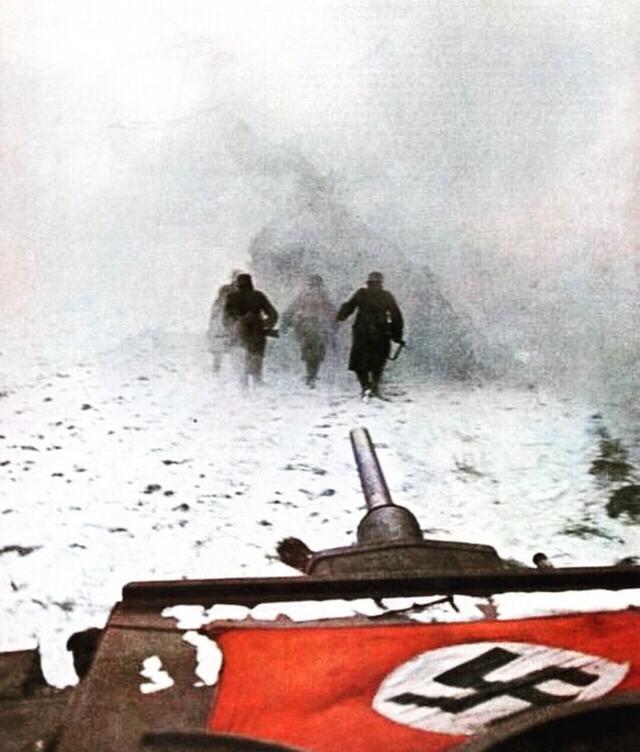Wounded by a thousand enemies and eight hundred self-inflicted losses, the Battle of the Soviet Union was a collision of boulders between the torrents of steel, and after the Battle of Moscow, the German army suffered heavy losses and was unable to launch a large-scale offensive. Hitler ordered the concentration of forces to occupy the wheat-producing areas (volga valley) and prepare to take the Caucasus oil fields and occupy Stalingrad.
Hitler thought that once the Soviet Union lost oil and food, Germany could win.
On May 8, 1942, the German Summer Offensive began. After two months of bloody fighting, the last Soviet stronghold was lost to the Germans and took Crimea.

On 11 July, germans entered Stalingrad. The vanguard forces were again fighting the Soviets on the first line of the Don River.
Hitler ordered the troops to divide into two routes: Hermann's armored forces and the 17th Army marching south to occupy the Caucasus oil fields,
On 22 July, the German 6th Army broke through the defensive line, only 120 kilometers from Stalingrad.
The two sides fought fiercely. After 20 days, the Germans finally broke through the Soviet line again.
Soviet hard-core resistance bought valuable time for the defense of Stalingrad.
On 19 August, the Germans launched their first major offensive against Stalingrad.
On the 22nd, German tanks broke through the Soviet line and reached the Volga River. Hundreds of German aircraft bombed the city indiscriminately. Within 10 days, the central defensive line of the Soviet army was broken, and the Soviet army withdrew into the inner encirclement line to fight for their lives. It took the Germans 26 days to invade the city and occupy most of the city.
The two sides immediately entered a brutal street battle, and the Soviets, workers, and militia fought brutally with german infantry with automatic rifles, grenades, and bayonets, and fought in the rubble for two months!
The Soviets had repelled more than 700 German charges from the beginning to the present [56], and the Germans continued to increase their troops, but they still could not take Stalingrad.
At the same time, Soviet reinforcements and supplies were continuously transported through the Volga to Stalingrad.
The Germans had also been fighting for months, exhausted and forced to turn to the defensive.
In early November, the Germans captured the "barricades" and broke through to the banks of the Volga River. But the main Soviet forces were firmly guarding the river, and until the Soviets launched a major counteroffensive, Hitler was unable to destroy Stalingrad. In the ongoing offensive, the German Sixth Army was exhausted.
The Soviets crushed Hitler's "Summer Offensive" plan, buying time for a full-scale counteroffensive.
The Germans suffered too many casualties, and the Soviets began to outperform the Germans in terms of strength and weapons in the stubborn confrontation. The Soviet high command decided to launch a counter-offensive.
In mid-November, Zhukov, assistant to the Supreme Commander of the Soviet Union, and Vasilevsky, chief of the general staff, launched Operation Hurricane. In the middle reaches of the Don River and around Stalingrad, 1.1 million Soviet troops were assembled and a major counter-offensive began
The Soviets successfully crossed the Don River, and several Soviet armies met in Karachi and surrounded the German Sixth Army under the city of Stalingrad.
On January 10, 1943, the Soviets fired 50 cannons at the enemy in the encirclement. The Germans collapsed.
The Germans were fierce enough to refuse to surrender.
On 22 January, the Soviets launched another full-scale offensive. The Germans ran out of ammunition, and Paulus, commander of the Sixth Group, asked Hitler to surrender, but Hitler did not agree!
On 30 January, the Soviets captured the headquarters of the German Sixth Army. Paulus finally surrendered at the last moment against the Führer's orders.
Two days later, the German Sixth Army was completely annihilated. The Soviets captured more than 90,000 Germans and annihilated all 330,000 Germans who were besieged
The Battle of Stalingrad was one of the largest battles of World War II.
Over a period of 200 days, the Germans lost a total of 1.5 million men, 3,500 tanks and artillery, 12,000 artillery and mortars, 3,000 aircraft and a large number of other munitions and technical weapons.
Since then, Germany has entered strategic defense.
The victory of the Soviet Union at Stalingrad, the fundamental turning point in the Soviet-German battlefield, made a decisive contribution to the victory of the entire Second World War.
It had a tremendous impact on the entire course of the Second World War. From then on, the Soviets seized the strategic initiative and held it until the end of the war.
After this battle, the United States, Britain, and the Soviet Union began to depict the future world pattern in Yalta.